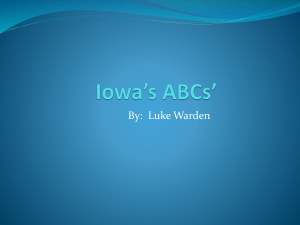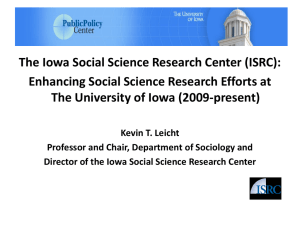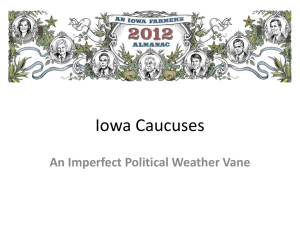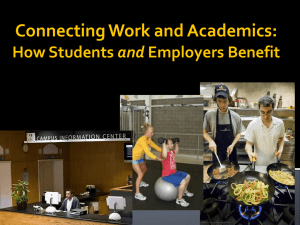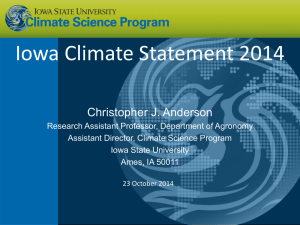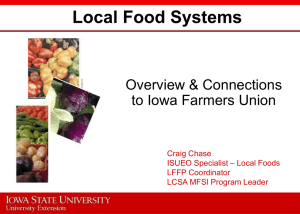Session 2 - PowerPoint
advertisement
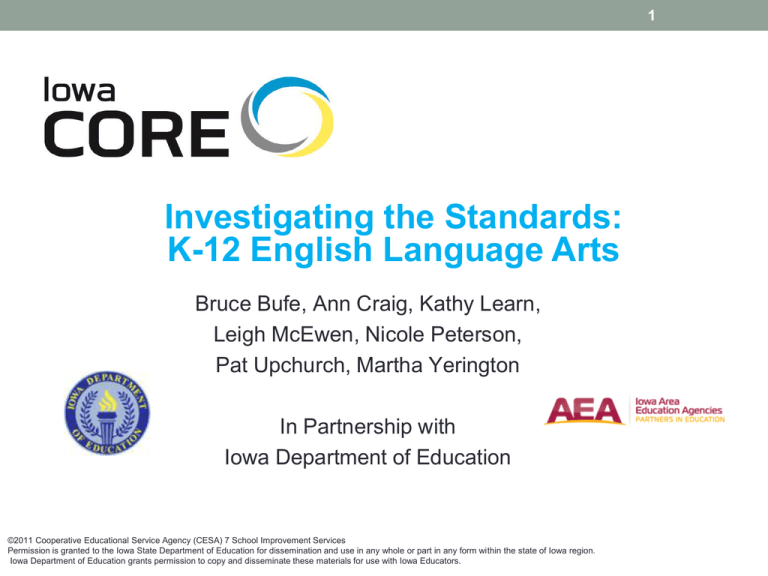
1 Investigating the Standards: K-12 English Language Arts Bruce Bufe, Ann Craig, Kathy Learn, Leigh McEwen, Nicole Peterson, Pat Upchurch, Martha Yerington In Partnership with Iowa Department of Education ©2011 Cooperative Educational Service Agency (CESA) 7 School Improvement Services Permission is granted to the Iowa State Department of Education for dissemination and use in any whole or part in any form within the state of Iowa region. Iowa Department of Education grants permission to copy and disseminate these materials for use with Iowa Educators. Agenda • Introduction to ELA Core Standards • Investigating the Standards: o Reading- Foundational Skills (K-5) o Reading -- Literature o Reading- Informational Text o Writing o Speaking and Listening o Language o Literacy - ELA Standards for History/SS, Science and Technical Subjects • Determining Implications and Action Steps 2 Iowa Department of Education grants permission to copy and disseminate these materials for use with Iowa Educators. 3 Reading Language ELA Writing Speaking & Listening ©2011 Cooperative Educational Service Agency (CESA) 7 School Improvement Services Permission is granted to the Iowa State Department of Education for dissemination and use in any whole or part in any form within the state of Iowa region. Iowa Department of Education grants permission to copy and disseminate these materials for use with Iowa Educators. 4 Reading Standards College and Career Readiness Anchor Standards K-5 6-12 Literacy in History/Social Studies, Science, and Technical Subjects 6-12 ©2011 Cooperative Educational Service Agency (CESA) 7 School Improvement Services Permission is granted to the Iowa State Department of Education for dissemination and use in any whole or part in any form within the state of Iowa region. Iowa Department of Education grants permission to copy and disseminate these materials for use with Iowa Educators. 5 College & Career Readiness Anchor Standards for Reading CCR Categories • Key Ideas and Details • Craft and Structure • Integration of Knowledge and Ideas • Range of Reading and Level of Text Complexity Major Organizing Structure Throughout the Reading Standards Specific Standards are Provided in Each Category by Grade Level/Band ©2011 Cooperative Educational Service Agency (CESA) 7 School Improvement Services Permission is granted to the Iowa State Department of Education for dissemination and use in any whole or part in any form within the state of Iowa region. 6 Investigation# 2: What information is found on the College & Career Readiness Reading Anchor Standards pages? Discussion Question to follow Parts A & B: Comprehension is a multifaceted process. How do the categories as well as the range and content of student reading help you understand this? ©2011 Cooperative Educational Service Agency (CESA) 7 School Improvement Services Permission is granted to the Iowa State Department of Education for dissemination and use in any whole or part in any form within the state of Iowa region. 8 College and Career Readiness Anchor Standards in Reading Reading Foundational Skills Reading Literature Reading Informational Text ©2011 Cooperative Educational Service Agency (CESA) 7 School Improvement Services Permission is granted to the Iowa State Department of Education for dissemination and use in any whole or part in any form within the state of Iowa region. Iowa Department of Education grants permission to copy and disseminate these materials for use with Iowa Educators. 9 Reading Standards: Foundational Skills (K-5) The Foundational Skills are necessary and important components of an effective comprehensive reading program which is designed to develop proficient readers with the capacity to comprehend a wide variety of text materials. Foundational skills foster understanding and knowledge of: • Print Concepts • Phonological Awareness • Phonics & Word Recognition • Fluency ©2011 Cooperative Educational Service Agency (CESA) 7 School Improvement Services Permission is granted to the Iowa State Department of Education for dissemination and use in any whole or part in any form within the state of Iowa region. Iowa Department of Education grants permission to copy and disseminate these materials for use with Iowa Educators. Investigation # 3 What is the purpose of the Foundational Skills? Discussion Questions for Part A: • What are the most important ideas in this section? • What do these mean for classroom teacher? Part B: Table Discussion Reading Standards: Foundational Skills (K-5) “Instruction should be differentiated: good readers will need much less practice with these concepts than struggling will. The point is to teach students what they need to learn and not what they already know – to discern when particular children or activities warrant more or less attention.” (Iowa Core, K-5 Reading Foundational Skills, p. 19) Note: Appendix A, pages 17-22. Implications for K-5 Teachers: • My classroom • ALL student (General Education, Special Education, ELL, At-Risk, Struggling Readers, etc.) • School/District/AEA partnerships • Record your thoughts on the Investigation Implications page. 13 Distribution of Literary and Informational Passages Grade 4 8 10 Literary 50% 45% 30% Informational 50% 55% 70% In order to match the NAEP Assessment Framework instructionally, a great deal of informational reading must take place outside of ELA in grades 6-12. 14 Investigation # 4: What are the progressions of sophistication in reading literature? ©2011 Cooperative Educational Service Agency (CESA) 7 School Improvement Services Permission is granted to the Iowa State Department of Education for dissemination and use in any whole or part in any form within the state of Iowa region. Iowa Department of Education grants permission to copy and disseminate these materials for use with Iowa Educators. 15 Reflection • What are the benefits of looking at this progression? • What are the implications for • teaching? • learning? • professional development? 16 Reading Literature Spiral With prompting and support, ask and answer questions about key details in a text. (RL.K.1) Refer to details and examples in a text when explaining what the text says explicitly and when drawing inferences from the text. (RL.4.1) Cite the textual evidence that most strongly supports an analysis of what the text says explicitly as well as inferences drawn from the text. (RL.8.1.) Cite strong and thorough textual evidence to support analysis of what the text says explicitly as well as inferences drawn from the text, including determining where the text leaves matters uncertain. (RL.11-12.1.) ©2011 Cooperative Educational Service Agency (CESA) 7 School Improvement Services Permission is granted to the Iowa State Department of Education for dissemination and use in any whole or part in any form within the state of Iowa region. Iowa Department of Education grants permission to copy and disseminate these materials for use with Iowa Educators. 17 Your Turn • On your own, pick one Literature anchor standard and follow it through the grade levels (k-12). Gr. K-5: pp. 11-14 Gr. 6-12: pp. 46-49 • What do you notice about the sophistication and complexity across grade levels? • How will these progressions impact your planning and your instruction? 18 Literature and Informational Text 19 Investigating Reading Standards for Informational Text Locate these standards in your document: • p. 15 (K-5) • p. 50 (Grades 6-12) Notice these organizational features: o Recurrent College and Career Readiness Categories o Specific grade-level standards o Iowa's added standards (IA.1, IA.2) in "Key Ideas & Details" ©2011 Cooperative Educational Service Agency (CESA) 7 School Improvement Services Permission is granted to the Iowa State Department of Education for dissemination and use in any whole or part in any form within the state of Iowa region. Iowa Department of Education grants permission to copy and disseminate these materials for use with Iowa Educators. 20 Investigation #5: How do the literature and informational text standards compare? Choose one standard from each Reading Standard Category for this investigation. Find someone at another table at your same grade level- discuss what you found. ©2011 Cooperative Educational Service Agency (CESA) 7 School Improvement Services Permission is granted to the Iowa State Department of Education for dissemination and use in any whole or part in any form within the state of Iowa region. Iowa Department of Education grants permission to copy and disseminate these materials for use with Iowa Educators. 21 Reading Informational Text Spiral With prompting and support, describe the connection between two individuals, events, ideas, or pieces of information in a text. (RI.K.3) Explain events, procedures, ideas, or concepts in a historical, scientific, or technical text, including what happened and why based on specific information in the text. (RI.4.3) Analyze how a text makes connections among and distinctions between individuals, ideas, or events (e.g., through comparisons, analogies, or categories). (RI.8.3) Analyze a complex set of ideas or a sequence of events and explain how specific individuals, ideas, events interact and develop over the course of the text. (RI.1112.3) ©2011 Cooperative Educational Service Agency (CESA) 7 School Improvement Services Permission is granted to the Iowa State Department of Education for dissemination and use in any whole or part in any form within the state of Iowa region. Iowa Department of Education grants permission to copy and disseminate these materials for use with Iowa Educators. Additional Resources to the Iowa Core • Appendix A – Research Supporting the Core; Foundational Skills details, Writing Types defined, Language Overview, Glossary (43 pp.) • Supplement to Appendix A (recently released): New research on Text Complexity (10 pp.) • Appendix B –Text Exemplars and Sample Performance Tasks. These text exemplars can be used without breaking copyright. (183 pp.) • Appendix C – Samples of Student Writing. (107 pp.)
